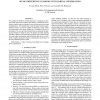493 search results - page 20 / 99 » Representing preferences using intervals |
ICML
2005
IEEE
14 years 8 months ago
2005
IEEE
The current framework of reinforcement learning is based on maximizing the expected returns based on scalar rewards. But in many real world situations, tradeoffs must be made amon...
ICASSP
2008
IEEE
14 years 2 months ago
2008
IEEE
We consider the problem of online learning in a changing environment under sparse user feedback. Specifically, we address the classification of music types according to a user�...
CCGRID
2009
IEEE
14 years 2 months ago
2009
IEEE
Highly distributed systems such as Grids are used today to the execution of large-scale parallel applications. The behavior analysis of these applications is not trivial. The comp...
VLDB
1994
ACM
13 years 11 months ago
1994
ACM
This paper presents an innovative partitionbased time join strategy for temporal databases where time is represented by time intervals. The proposed method maps time intervals to ...
KDD
2003
ACM
14 years 8 months ago
2003
ACM
A recommender system suggests the items expected to be preferred by the users. Recommender systems use collaborative filtering to recommend items by summarizing the preferences of...

